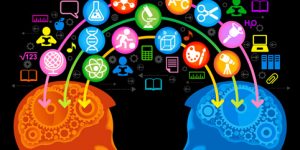
e-Content is the core of any single or multi-media application, whether commercial or not. Practically almost any website, CD, video, or mobile application is built to carry the content to the user or to help the user create his/her own content. E-content today is mostly viewed as a way to preserve and carry forward cultural or historical heritage, to disseminate lifestyle, scientific, educational and business information in some digitalised format, or to provide some interactive service to users. E-learning is one vital category for e-content interventions and delivery. By now various methods of content delivery and innovations have sprung up in e-learning.
Across the world
Use of ICT in education or in that case growth and development of e-content for e-learning is at various stages of development and application. Countries and societies are on continuous drives to make a viable platform for e-learning through effective and utility based content structure and delivery. Gradually social structures and institutions are being moulded to see the effectiveness and viability of having e-learning modules and practices for multiple gains. For this there is continuous search for value based content across societies and institutions. The target is to enrich upon the existing knowledge driven society. In Brazil universities are investing to supply improved teaching and learning resources via digital media. E-learning is the most developed aspect of -content in Jordan and the Jordanians are proud of Jordanian EduWave (www.itgsolutions.com) winning the WSIS Award connecting schools and Universities. is a method of teaching English academically through a cube interface to children. Learning Objects (www.viitindia.org) is a project in India that aims at creating a knowledge utility uses SCORM (Sharable Content Object Reference Model) for Multimedia enriched? educational content in rural schools in India. In Tanzania some multimedia projects are in operation that helps people to study or to improve their skills. In China, Hong Kong Education City
(http://www.hkedcity.net) strives to build a one-stop learning portal where communities can learn, share, contribute and exchange ideas. In Italy, a developed country, Droit Partages (www.droitspartages.org) is dedicated to fighting for children’s rights. Its aim is to promote awareness in children and young people to help them grow into open-minded citizens, respectful of each other, and capable of making their own life choices everyday. At other levels, e-learning is getting a boost through cross country and cross institutional arrangements.
Issues involved
e-learning and content are inseparable and the former rely on the latter. Content and e-learning faces a number of challenges in coming out with viable modules for information enriched society and institutions. In fact, most of the challenges in econtent in India aptly apply to e-learning challenges as well. These include:
Lack of basic ICT infrastructure like telephone, power supply and Internet connectivity
Lack of computer knowledge and training among majority of people
High costs of ICT equipments including computers which hinders access to ICT due to financial issues
Lack of knowledge of ICT and its application
Absence of a sound ICT policy initiatives in the form of tax incentives, abolition of tariffs or certain taxes and on IT equipments
Low broadband penetration as a bottleneck for development of? media-rich e-content
Low level of investments in production of learning and educational programs and materials
Less development of user friendly applications
Risk prone cultural and commercial culture in many societies toward technical innovations and applications
Not enough political and administrative support in many countries
Lack of strategic vision of information society development
Absence of adequate legislative framework for deployment of information society
Absence of coordination between state and public organizations in the area of
content framework and overall info society.
Need for a viable content?structure
Development and spread of e-learning networks across societies, especially the underdeveloped and developing countries, call for urgent attention on? certain key issues. The following issues stand significant in determining the e-learning status of societies together with the overall e-content structure:
A clear ICT policy from the government
A proactive policy for bridging the digital divide
Allow financial incentives in ICT interventions including in elearning ventures
Enhance ICT awareness and spread in communities and people
Incentive academic courses on ICT across countries and societies
Environment for developing elearning solutions that is feasible, accessible and utility based
Effective public-private partnerships in promotion of elearning content ventures in schools and institutions
Ease of access of content online and through other communications technology
Development of proper and effective e-learning software through effective course delivery and content
Continual advances in value addition through use of latest applications such as educational animation to be made available to support online learning
Open source e-learning systems such as Blackboard, Moodle, ATutor, ILIAS, need to be used effectively towards a student centred learning solution.
Content structure, value and applicability are vital to effectively handle e-learning solutions and? modules and their use across societies. However, this alone is not enough. E-learning solutions and software and its usability is equally pertinent to take note of. Most often HTML is used to bind together the different e-learning media. Sometimes XML based files are created which are then rendered to HTML/CSS/ JavaScript by using an XSLT transformation. However often proprietary technologies are used like Macromedia Flash, an authoring tool, which leverages the JavaScript-like language called ActionScript to enable advanced functionality and interactivity. Data conferencing applications are sometimes used to share and manipulate e-learning media. These issues may need to address with caution and urgency.
Pro-Active Steps Required
If technology is empowerment, then this is the right medium for education and learning across societies and? nation states. What is good to know is this ICT has enabled societies to? innovate learning practices and modules and share this learning and inventive experiences notwithstanding distance and differences based on culture and otherwise. It is equally vital to understand that countries are not equally placed in terms of socioeconomic frameworks. This has a bearing on the quantum of time and resources being spent on ICT based interventions in various spheres of existential domains. Further, research into innovative e-learning solutions should result in a lowering of the? technological barriers, enabling learners and users to use existing, widely available technologies as well as new technologies in content and elearning perspectives. Well said, research activities should address the needs of socially, physically or technically disadvantaged groups across societies.







